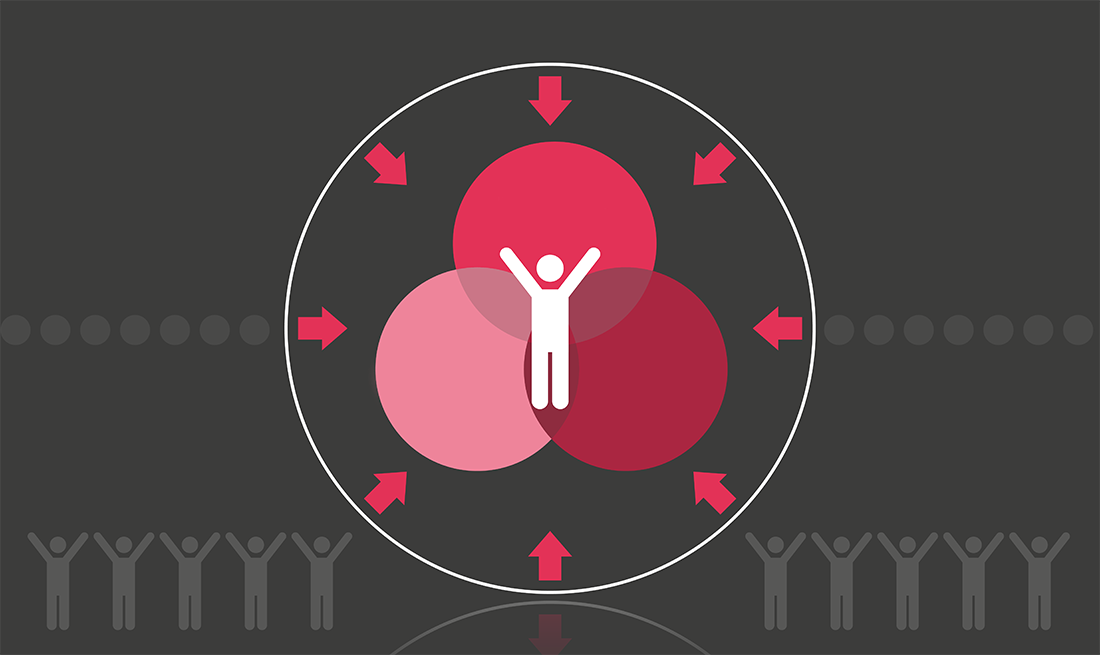![]()
| A student's current level of development interacts with the social, emotional and intellectual climate of the course to impact learning. |  |
Can you remember what it felt like to be a student? Exciting? Daunting? Intense?
- Learning does not take place in a vacuum and a student's current level of development impacts on their learning.
- A student's intellectual or emotional maturity can be at different stages.
- Development isn’t always a straightforward linear process; students can ‘get stuck’ or move backwards as well as forwards.
According to Ambrose, most research into student’s intellectual development shows a trajectory from simplistic to more sophisticated ways of thinking. Let’s look at Perry’s model of cognitive development as an example of this trajectory to consider the characteristics of each stage of development.
As you read through the following model of cognitive development, reflect on where you think your students are on this journey. Think about how you can set student’s challenges that are appropriate to their level and help expose the limitations of their current view, to encourage them to move forward.

- There are only right and wrong answers
- Tutor or text book as the voice of authority
- Student’s role is to absorb and remember tutor’s instruction
- Knowledge acquistion is quantitative
- Everyone is entitled to their own opinion
- Opinions are subjective and no one is better or worse than another
- Tutor is just another opinion
- Student’s can begin to construct their own knowledge
- Not all opinions are equal
- Opinions can be evaluated on the basis of evidence
- Knowledge acquisition is qualitative
- Tutor as guide or mentor
- Students commit to a base theory on which to build and refine
- Views are more nuanced and informed
- A student’ s movement forward is usually propelled by a challenge that reveals the inadequacies of the current stage. (Ambrose)
- Intellectual development doesn’t happen overnight. It can’t be forced but it can be encouraged and nurtured by giving appropriate challenge and support (Vygotsky, 1978)
- Many students leave college in the multiplistic stage (Baxter- Magolda)
- You need to make sure your expectations are reasonable given students’ current level of intellectual development: what is reasonable for a graduate may not be for a first- year student, and vice versa (Ambrose)
The basic premise of identity theory is that identity is not a given; instead, it needs to be achieved and continually negotiated as individuals try to balance developmental tensions and tasks throughout their lives (Erikson,1950).
In addition to the student’s trajectory in their personal development, the course climate also has a significant impact on their motivation and engagement with the course.
What do we mean by course climate? It’s a combination of all the factors that make up the student's learning environment.
- What tone does the tutor set and how do they interact with students?
- Course demographics – the makeup of different groups within the class
- Student-to-student interaction
- The range of perspectives included in the course material
- Stereotyping or tokenism
Studies suggest that course climate does not have to be blatantly exclusive or hostile in order to have a marginalising effect on students and that, although each instance of subtle marginalisation may be manageable on its own, the sum total of accumulated "micro-inequities” can have a profound negative impact on learning (Hall, 1982).
Beyond a simple scale of hostile or productive environments, DeSurra & Church’s (1994) research into the experiences of LGBT students found that course climate is more of a continuum.

- Overtly hostile
- Discriminatory
- Unwelcoming
- Exclude certain groups
- Subtle and indirect exclusion
- Unintentional off-putting messages
- Unplanned responses that validate alternative perspectives and experiences
- Marginalised perspectives intentionally and overtly integrated in the content.
- Discussion ground rules and course policies) to foster sensitivity to the perspectives that students bring to the classroom.
Assuming we all want to create productive, centralised and supportive course climates for all our students, let’s consider four basic areas that can have an impact.
It probably comes as no surprise that the overt stereotyping in classrooms has a negative and marginalising effect. What’s perhaps less known is that subtle activation of stereotypes is also profoundly damaging.
“Stereotype threat is a complex and nuanced phenomenon, but in simple terms it refers to the tension that arises in members of a stereotyped group when they fear being judged according to stereotypes. This sense of threat can negatively affect these individuals’ performance on tasks (regardless of their ability), their level of preparation, their self confidence, or their own belief in the stereotype.” (Steele & Aronson, 1995).
- Comments by tutors that come from assumptions about student groups abilities or that assume that students share the same beliefs and values as the tutor
- Tokenism – for example relying on minority students to represent a certain cultural view
This is about the tone you use to communicate with students. It’s not just about what you say, but the way you say it. So, a welcoming, supportive and constructive tone will encourage students to perceive you as approachable. This also includes how you respond to student infringements!
Let them know you care! Astin (1993) found retention was increased where students felt faculty were interested their academic problems, cared about the concerns of minority groups, were approachable outside of class, and treated students as persons and not as numbers.
It’s not just how you teach that influences climate, what you teach is also important.
Marchesani and Adams (1992) describe a continuum of inclusion for course content.
- Exclusive Curriculum - only a dominant perspective is represented
- Exceptional Outsider - a token marginalized perspective is included only to comply with a requirement
- Transformed Curriculum - multiple perspectives are placed at the centre.
According to Ambrose, for students who are developing their sense of identity, purpose, and competence, some of these messages can translate into messages about their own power, identity, and agency and can influence engagement and persistence in the field.
We need to think of our students holistically as intellectual, social, and emotional beings who are still developing within the course climate we create.
Let’s now look at some strategies we can put in place to encourage student development within a productive environment.


Support the student’s developmental journey
- Validate different points of view, even if they are difficult.
- Let students know that to engage in critical thinking they need to embrace complexity.
- Classroom discussions help us all broaden our world view – the aim isn’t to reach a consensus.
- Support students in examining a situation from several points of view.
- Try asking them to give their views before you give yours, to avoid biasing them with the voice of authority.
- If you want students to support their opinions with evidence, use rubrics and other tools to scaffold this practice.
- Examine your assumptions about students
- Remember students are likely to have a different background and frame of reference than you.
- Avoid making assumptions about a student’s ability based on stereotypes.
- Be mindful of low-ability cues. For example: “l will be happy to help you with this because I know girls have trouble with math”.
- Do not ask individuals to speak for an entire group.
Minority students often report either feeling invisible in class or sticking out like a sore thumb as the token minority. This experience is heightened when they are addressed as spokespeople for their whole group.
- Make sure course content does not marginalise students
- Remember what is excluded is important too as it implies a value judgement.
- Use Multiple and Diverse Examples to help students from all groups feel connected to the content.
- Establish and reinforce ground rules for interaction.
- Model inclusive language, behaviour, and attitudes.
- Use the syllabus and first day of class to establish the course climate.
- Reduce anonymity.
- Make students feel recognised as individuals, both by the instructor and by peers.
- Facilitate active listening.
- Sometimes tensions arise because students are not hearing what others are saying. To build this important skill and enhance classroom interactions, you might ask students to paraphrase what someone has said, followed up by a series of questions as to whether their perception was inaccurate or incomplete. You can also model this skill yourself by paraphrasing a student’s response and then asking whether you captured their perspective accurately.
- Turn discord and tension into a learning opportunity.
- Students need to learn that debate, tension, discord and cognitive dissonance are all opportunities to expand one’s perspective, delve deeper into a topic, better understand opposing views, and so on; hence, we need not avoid them.
- Anticipate and prepare for potentially sensitive issues.
- Address tensions early.
- Take a student aside after class to explain the impact of a comment, explicitly discussing the tension.
- Remember that college students are learning to manage their emotions and sometimes don’t know how to express them appropriately. In these cases, you might want to discuss intent versus impact. This strategy protects students who make unsophisticated comments so that they do not shut down and foreclose further development, while acknowledging the frustration of the rest of the class.
Because some alienating attitudes, behaviours and language function under the surface, it's not always easy to get a sense of whether everyone in the class feels equally valued, accepted, heard and so on.
- Ask student reps to help
- Use evaluations
- Video yourself
- Ask your TA for feedback
- We need to think of our students holistically as intellectual, social, and emotional beings. They don’t leave their personal and social identities at the door of the classroom!
- You can set student’s challenges that are appropriate to their level and help expose the limitations of their current view, to encourage them to move forward in their intellectual and social development.
- Although you can only encourage development, you can have a great impact on the course climate by deliberately making the course content and tone explicitly centralised and facilitating positive interactions
